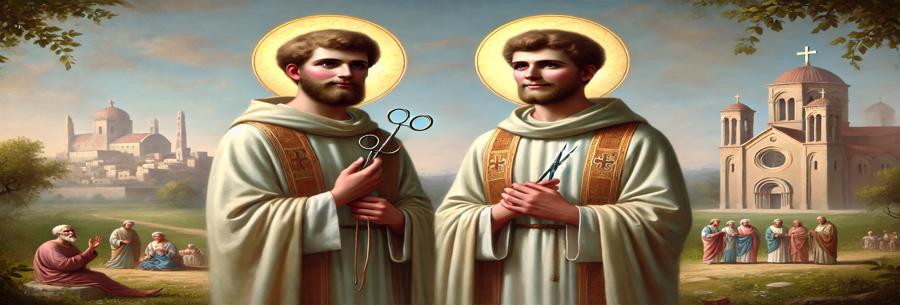Saints Como and Damian, twin brothers from Arabia, are famous in Christian tradition as miraculous healers and martyrs of the faith. Their story, which has spanned the centuries, is deeply rooted in the tradition of the first Christian martyrs, embodying both the Christian faith and dedication to medicine. Celebrated for their charity and refusal to receive payment for their medical services, they are often referred to as the "anargyres", a Greek term meaning "without money".
Origins and Life in Arabia
The historical details of their lives are difficult to pin down precisely, largely because many aspects of their story are based on hagiographic accounts (holy narratives) rather than historical documents. Nevertheless, according to tradition, Como and Damian were born in the third century in Arabia, into a pious Christian family. From childhood, they are said to have shown an interest in medicine and a deep compassion for the sick.
Having probably studied medicine in schools in the Roman Empire, which at the time offered fairly advanced medical training, the two brothers used their knowledge not only to cure physical ailments, but also to attract people to the Christian faith. For them, medicine was a way of expressing their faith, of showing God's love through their actions.
The Medical and Spiritual Ministry
Comeus and Damian are best known for their practice of medicine, which they offered free of charge to anyone who needed it, rich or poor. Their reputation as healers spread rapidly throughout the region, and people flocked from all over to receive treatment. Their medicine was not only physical, but also spiritual. They often prayed for their patients and attributed their healings to divine intervention rather than to their medical skills.
According to Christian tradition, the two brothers cured illnesses that the medicine of the time could not treat, reinforcing the idea that they were endowed with a special gift. They are reputed to have performed miracles, healing the sick simply by prayer or the laying on of hands, and even raising the dead. One of the most famous accounts recounts the healing of a seriously ill woman who, after praying for their intercession, was miraculously cured. Their commitment to the Christian faith and their refusal to receive any payment for their services were also expressions of their devotion to God. They saw each patient as an image of the suffering Christ, and treating them without expecting anything in return became an act of charity and faith.
Persecution and Martyrdom
At the time, the Roman Empire was still largely pagan, and persecutions against Christians were frequent, particularly under the reigns of the emperors Diocletian and Maximian. Como and Damian lived in a region which, although partially Christianised, was still under the control of pagan Roman governors. Their growing popularity, both as doctors and influential Christian figures, attracted the attention of the Roman authorities.
The two brothers were arrested on the orders of the governor Lysias, who saw their influence and refusal to participate in pagan cults as a threat to public order and Roman authority. Lysias asked them to renounce their Christian faith and sacrifice to the Roman gods, which they categorically refused to do. Their response, marked by faith and courage, was that they could not betray their God, even at the cost of their lives.
Comeus and Damian were then subjected to various tortures in an attempt to make them recant their faith. According to the hagiographic accounts, they were beaten, hanged from a cross, stoned and even tied to poles to be burnt alive. Miraculously, however, they survived all these attempts on their lives, which further strengthened the faith of the local Christians and their devotion to the two brothers.
Finally, Como and Damian were beheaded, thus completing their martyrdom. Their martyrdom took place around the year 287, during the reign of Diocletian, in the city of Cyr, in Syria.
Veneration and Posthumous Influence
After their deaths, the relics of Saints Como and Damian very quickly became objects of veneration. Miracles attributed to their intercession multiplied, and their cult spread rapidly throughout the Roman Empire, particularly in the East and in Italy. Their tomb became a place of pilgrimage for Christians, and many miraculous cures were reported by those who prayed for their intercession.
The two brothers were canonised very soon after their deaths, and their cult was included in the liturgy of the Christian Church. In the 6th century, Emperor Justinian had a basilica built in their honour in Constantinople, after being miraculously cured of a serious illness thanks to their intercession. Their cult soon spread to Rome, where another basilica was built in their honour, the Basilica of Saints Como and Damian, which still stands today in the Roman Forum.
Saints Como and Damian have become the patron saints of doctors, pharmacists, surgeons and all the medical professions. Their feast day is celebrated on 26 September in the Western liturgical calendar, and on 1 November in the Orthodox Church. As "anargy saints", they are also examples of charity and selfless devotion to others.
Legends and Miracles
Many miraculous stories surround the lives of Saints Como and Damian, even after their deaths. One of the most famous tells how, during a miraculous posthumous operation, a man, having seriously injured his leg, prayed to the two saints for healing. He dreamt that Como and Damiano appeared in his sleep, replacing his injured leg with that of a black man who had just been buried in a nearby cemetery. When he awoke, he found that his leg had been healed, and this miracle became one of many stories attributed to the intercession of the two brothers.
These stories helped to reinforce their reputation as miraculous healers, and their legend has been perpetuated in Christian art and religious literature over the centuries. They are often depicted in Christian iconography with medical instruments, such as scalpels or medicine boxes, or healing the sick.
Conclusion
Saints Como and Damian are much more than mere religious figures: they embody a model of service and dedication to others, a life entirely devoted to healing body and soul. Their example is still a symbol of selflessness, unshakeable faith and courage in the face of adversity. Their lives and martyrdom inspire not only healthcare professionals, but all those who seek to live a life of compassion, charity, and selfless service to others.




















